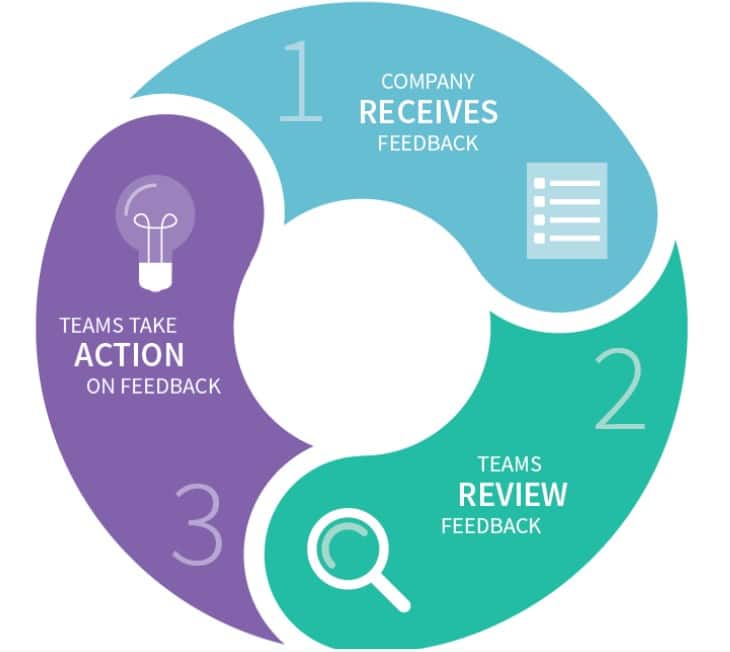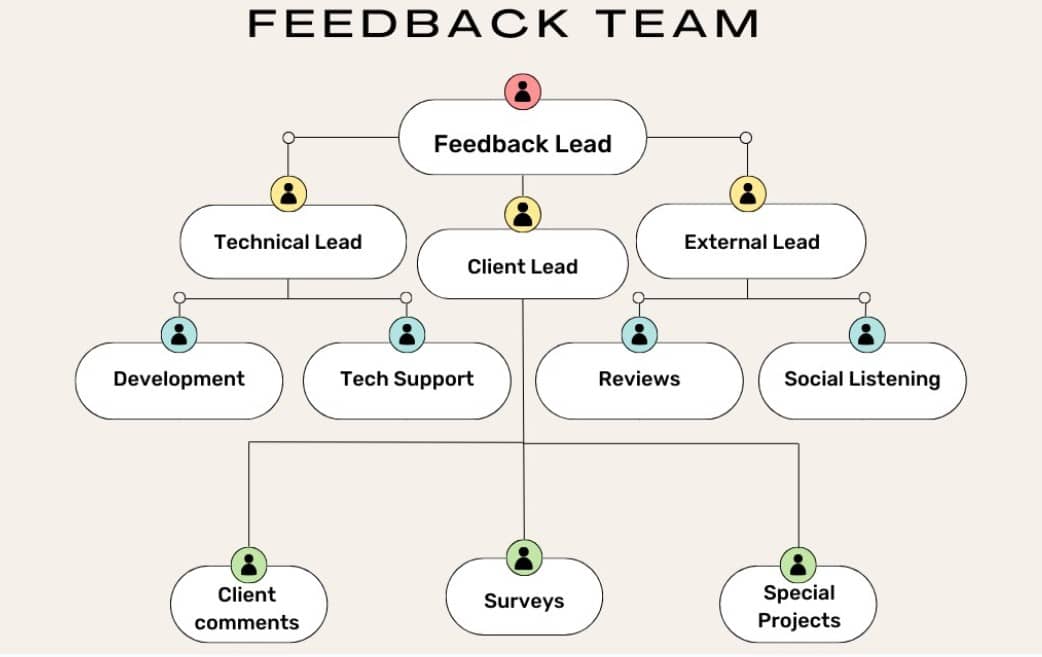How closely do you listen to your customers?
Most businesses will tell you they put their customers first, but some manage it much more effectively than others. When it comes to software as a service (SaaS) companies, actively addressing concerns is paramount. The competition in the SaaS space is so acute that those who don’t have a habit of falling by the wayside.
Building a high-quality customer feedback loop is critical—but how exactly should SaaS businesses go about it?
A customer feedback loop is the process of eliciting feedback from customers, analyzing it, and then acting on the insights gained.
Both positive and negative feedback should form part of this process. If your customers are happy, great—you can learn a lot from positive feedback loops about what you’re doing well and even develop a greater understanding of customer behavior and preferences.
If, on the other hand, your product is somehow unsatisfactory or you’ve fallen into a common customer service pitfall, it’s even more important to understand where you went wrong. This way, you can begin to make amends and implement changes to improve your performance.
Why closing the loop matters
What does it mean to close the loop? This refers to returning to the starting point via the final stage of the process, when you act on the learnings you’ve uncovered. Corrective feedback is one of the most valuable assets your business has access to—but only if you use it wisely. There are several reasons why this is important.

Image sourced from centercode.com
Improves customer satisfaction
First and foremost, accepting constructive feedback from customers helps you deliver a more satisfying experience. For one thing, it makes your clients feel listened to, which is a fundamental building block of any trusting relationship.
Of course, the other way it improves customer satisfaction is by helping you build a better product or service. In turn, this should lead directly to an uptick in CSAT scores and a happier customer base.
Boosts brand reputation
When your customers see that you’re serious about mounting an effective feedback response, it boosts your reputation as a brand too. In fact, putting comprehensive customer feedback systems and processes in place can contribute a huge amount to your business’s brand identity.
Contributes to raising standards
There are two ways that acting on feedback raises standards: directly and indirectly. It has a direct effect when you apply insights to your product or service to improve them. But it also has an indirectly positive effect on standards, because when your employees are aware that you act on feedback, it increases their accountability. In other words, it motivates them to do better.
SaaS-specific characteristics to note
Before examining how a SaaS business should implement a customer feedback loop, it’s worth noting a few points about this particular business model. That’s because it has certain characteristics that affect how you elicit and act on feedback. These include:
Long sales cycles
A SaaS product isn’t a T-shirt or a fast-moving consumer good. B2B SaaS demand generation is a complex web of marketing, lead development, and research. It focuses on raising brand awareness via a variety of techniques, including digital marketing, data-led SEO, and content management.
When a company decision-maker is looking for a SaaS solution, they typically spend a long time researching options before committing to a purchase. There may well be multiple layers of management involved in the final decision; in other words, it’s not an impulse buy. This means that sales cycles in the SaaS sector tend to be pretty long – six to 12 months isn’t uncommon.

Hyper-specialization
By their nature, SaaS products tend to be highly specialized. Mostly, they’re developed to fit a niche in the market, and so they have a very specific target audience. While some companies do branch out into related areas, it’s common for SaaS businesses to maintain a narrow focus to try to become an outstanding name in their field.
Competition is fierce, and there’s much to play for. At the current rate of growth, the global SaaS market is expected to be worth over $900 billion by 2030. That’s up from around $274 billion in 2023.
Apart from a few big players, businesses have to specialize to have any chance of securing their piece of the pie.
Importance of customer retention
As the industry is competitive and it takes so long to attract new customers, keeping them once you have them is key. Even medium-sized SaaS companies can feel the hit if they lose just a single large client. For smaller start-ups, this unfortunate circumstance can sometimes be terminal.
Partly, this is because it’s difficult to pivot to a completely different product quickly given the hyper-specialization mentioned earlier. SaaS products are often fairly complex beasts that take time to develop, so customer retention is crucial for long-term business success.
How to develop a customer feedback loop in SaaS
Given these factors, it should be obvious that customer feedback loops play a particularly important role in the SaaS industry. While companies can attract customers using the same techniques as any other business, such as digital marketing and B2B SEO services, keeping them is another matter.
A chain retailer might be able to absorb the loss of a few dissatisfied customers without any problem, but the same can’t be said for companies operating in the SaaS space.
So, if you’re in the software-as-a-service game, how should you go about implementing a customer feedback loop? Let’s take it step by step.

Step 1: Collect feedback from customers
It all begins with collecting feedback. This will come from a variety of sources, such as:
- Surveys. Contact customers and ask them directly for their thoughts so you can generate crucial metrics like your net promoter score and CSAT.
- Customer support feedback. When a client requires support, ask for their opinion on the quality of service you provided, including their experience with omnichannel customer service.
- Social media listening. How to conduct systematic monitoring of all your social media channels and mentions should be a core element of the social media training you give your staff.
- Bug reports. If there’s a problem or glitch in the product, it’ll show up in your bug reports, so these also count as feedback as they have a direct bearing on service improvement.
- Review sites. These are a particularly rich seam of customer feedback because you’re more likely to find brutally honest opinions on them.
- Focus groups. These allow you to explore customer concerns in more depth, although they’re pretty time-intensive, so you’ll generally need to compensate your clients in some way for taking part.
Each of these approaches will yield different types of insights, so it’s best to deploy as many of them as possible. The objective is to develop a deeper understanding of the customer experience.
You can map out your audience’s pain points using a maturity assessment. Let them fill out the assessment and then you can analyze the results. This can help you find ways to better meet your customers’ needs.
Step 2: Analyze feedback
It’s vital to approach your analysis objectively and systematically. Create a plan for reviewing each type of feedback and a dedicated team drawn from across the business to enact it.
The basic structure of the team might look something like this:

Image created by writer
Select individuals with appropriate expertise to fill each role and set out exactly what each person is responsible for. For instance, if you’re using focus groups, these would feature under “Special projects”, and the staff member you assign this to should have experience in designing and hosting them.
Your feedback team should meet regularly to discuss the latest information they’ve collected. One of the main advantages of this approach is that it reduces the risk of silos developing.
In the run of everyday operations, it’s easy for technical teams to lose touch with the customer-facing side of things, but for SaaS businesses, it’s crucial they stay plugged into your client experience.
Step 3: Implement changes
With feedback collected and shared, the next stage is to decide what changes to make and how to implement them. In most cases, solutions will suggest themselves. For example, if you’re receiving a lot of complaints about one particular aspect of your product, the technical lead should feed this back to the development team for them to solve.
There may also be some feedback about aspects of your service that aren’t quite so cut and dry and need cross-team strategizing in response. For instance, if you use a chatbot on your site and your clients suggest this isn’t giving them useful answers, it might not be realistic to resolve this issue quickly. After all, it’s not necessarily a straightforward matter to rapidly adapt a chatbot so it can determine answers to every complex client query.
Instead, you might need to consider expanding your human support team, but this can also take time. Do you have the budget for it? How quickly can you onboard and train new staff? Sometimes, the best response will involve multiple departments coming together to contribute in the short term while you develop a full solution over a longer period.
Additionally, exploring the benefits of chatbots in your customer support strategy can also be advantageous. Chatbots can efficiently handle common customer inquiries, freeing up your human support team to focus on more complex issues.
Once you’ve made changes, don’t forget to follow up with clients to explain what you’ve done and ask for more feedback. This takes you back to the start of the loop, at which point you go around it again.
Koa Frederick is the Senior Vice President of SaaS strategy at accelerate agency, a SaaS digital marketing agency that exclusively partners with enterprise tech companies to scale their SEO and content marketing. Koa has extensive experience in growing SaaS brands via organic leads and loves to write in her spare time. Here is her LinkedIn.
Final thoughts—boosting your brand with a customer feedback loop
When it comes to PR, SaaS companies can put themselves in a great position by proving they pay attention to their customers. In such a competitive space, it’s crucial to actively listen to and try to resolve their concerns.
Putting a well-thought-out customer feedback loop in place can help improve the customer experience and boost client retention. For SaaS businesses, this is the best way of ensuring long-term success in an increasingly crowded market.



